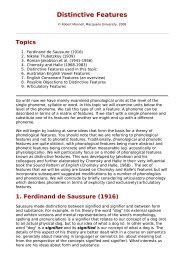Festival Speech Synthesis System: - Speech Resource Pages
Festival Speech Synthesis System: - Speech Resource Pages
Festival Speech Synthesis System: - Speech Resource Pages
Create successful ePaper yourself
Turn your PDF publications into a flip-book with our unique Google optimized e-Paper software.
`stress'<br />
This item's lexical stress<br />
`n.stress'<br />
The next syllable's lexical stress<br />
`p.stress'<br />
The previous syllable's lexical stress<br />
`R:SylStructure.parent.name'<br />
The word this syllable is in<br />
`R:SylStructure.parent.R:Word.n.name'<br />
The word next to the word this syllable is in<br />
`n.R:SylStructure.parent.name'<br />
The word the next syllable is in<br />
`R:SylStructure.daughtern.ph_vc'<br />
The phonetic feature vc of the final segment in this syllable.<br />
A list of all feature functions is given in an appendix of this document. See section 32. Feature functions. New<br />
functions may also be added in Lisp.<br />
In C++ feature values are of class EST_Val which may be a string, int, or a float (or any arbitrary object). In Scheme<br />
this distinction cannot not always be made and sometimes when you expect an int you actually get a string. Care<br />
should be take to ensure the right matching functions are use in Scheme. It is recommended you use stringappend<br />
or string-match as they will always work.<br />
If a pathname does not identify a valid path for the particular item (e.g. there is no next) "0" is returned.<br />
When collecting data from speech databases it is often useful to collect a whole set of features from all utterances in a<br />
database. These features can then be used for building various models (both CART tree models and linear regression<br />
modules use these feature names),<br />
A number of functions exist to help in this task. For example<br />
(utt.features utt1 'Word '(name pos p.pos n.pos))<br />
will return a list of word, and part of speech context for each word in the utterance.<br />
See section 26.2 Extracting features, for an example of extracting sets of features from a database for use in building<br />
stochastic models.<br />
[ < ] [ > ] [ > ] [Top] [Contents] [Index] [ ? ]<br />
14.7 Utterance I/O<br />
A number of functions are available to allow an utterance's structure to be made available for other programs.<br />
The whole structure, all relations, items and features may be saved in an ascii format using the function utt.save.<br />
This file may be reloaded using the utt.load function. Note the waveform is not saved using the form.<br />
Individual aspects of an utterance may be selectively saved. The waveform itself may be saved using the function<br />
utt.save.wave. This will save the waveform in the named file in the format specified in the Parameter<br />
Wavefiletype. All formats supported by the Edinburgh <strong>Speech</strong> Tools are valid including nist, esps, sun,<br />
riff, aiff, raw and ulaw. Note the functions utt.wave.rescale and utt.wave.resample may be used<br />
to change the gain and sample frequency of the waveform before saving it. A waveform may be imported into an<br />
existing utterance with the function utt.import.wave. This is specifically designed to allow external methods of<br />
waveform synthesis. However if you just wish to play an external wave or make it into an utterance you should<br />
consider the utterance Wave type.
















